


Rectal prolapse have a protrusion (prolapse) of the rectum through the anus. The rectum folds on itself and protrudes through the anal canal. Patient may also have such symptoms as a change in bowel habits, rectal bleeding, mucus drainage, anorectal pain or fecal incontinence. A rectal prolapse is thought to occur because of a loss or weakness of the normal support structures for the rectum.
Laparoscopic rectopexy is a surgery to repair a rectal prolapse, a protrusion of the rectum through the anus. In this surgery, the rectum is restored to its normal position in the pelvis.
Rectopexy can be executed by both open and laparoscopic procedures. However, the laparoscopic technique is highly approved by the laparoscopic surgeons because it is a minimally-invasive surgery, and a laparoscopic surgical method has immense advantages and a high success rate than conventional open surgery. Some of the advantages of a laparoscopic rectopexy, when compared to an ordinary open rectopexy, are as follows:
The chances of recurrence is extremely low after laparoscopic rectopexy as the surgeons after fixing the protruding rectum make usual stitches with a surgical mesh instead. The surgical mesh ensures that the rectum does not come out of its place, thus saving the patient from a recurring prolapsed rectum.